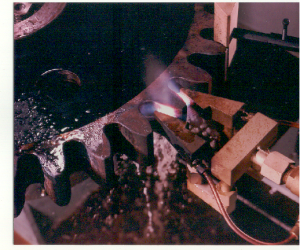The Real Question Is Determining Your Tolerance For Distortion.

This week I’m going to discuss the problem of distortion. Well, it’s only a problem when the distortion is considered excessive – when the heat or cooling cycles of the process distort the part beyond your specified tolerances. Think about what happens to asphalt in heat waves or Polar vortices and you realize that distortion is GOING to happen because heat causes everything to expand and cold causes it to contract – changing its dimensions in the process. So the question then shifts from how to get rid of distortion to determining your tolerance for distortion and establishing a process that keeps your production line within that tolerance. It’s easier on paper than in practice. That’s why we see so many symposiums on excessive distortion at trade shows.
To start with, identify any potentially extreme changes to the part during manufacturing. For example, if a part needs a lot of machining, the stresses introduced there could destabilize the part enough to cause excessive distortion when it goes through heat treating. With a cast iron part, incorrect cooling can cause too much destabilization as well. In these cases you want to increase the part’s stabilization before you heat treat it. A good rule of thumb: the more stressed a piece of steel is before heat treating, the more likely you will see excessive distortion afterwards. To stabilize a part before heat treating, you could use a furnace to apply a more uniform heat before you heat a part of it to the ideal temperature for hardening. So it’s always best to start out with as stable a piece as possible.
Now let’s look at distortion issues within the heat treating process. First focus on the geometry of the part. That determines which areas are going to heat and cool faster than others. Non- uniform heating and quenching can cause excessive distortion, so at FTSI we try to include in our design a uniform application of heat to the specified areas of the part. Sometimes the discrepancies in the part itself create a design challenge.
For example, take a ring gear with non-uniform thickness. The thinner areas heat faster and the uneven heat absorption causes warping beyond tolerance. In a case like this we design “heat sinks” to take the heat away from the hardening area enough to reduce distortion to within tolerance. Sometimes heat sinks can be specially designed quench applications or even an additional layer of steel covering the vulnerable areas. Whatever it is, it can absorb the extra heat so the part doesn’t have to.
Gears especially suffer from non-uniform problems. When the entire gears gets heated very fast and then dropped into the quench it’s not unusual to see excessive distortion of the whole piece. In a case like that we recommend tooth-at-a-time heating so that only the teeth deal with the heat and the quench, not the entire gear.
If you’re using flame, one of the more counter-intuitive tricks that helps with distortion is adding more flame heads so you can reduce the time the part spends in the heat cycle. The faster you heat, the less distortion you have. Any time you heat the WHOLE part up, distortion naturally increases because more mass is absorbing more heat. More flame heads reduce the time the part spends under extreme heat so your absorption rate drops and you limit the amount of distortion you get.
Once again we’re reminded it’s not just the heat, it’s the cool. Improper quench design and materials can also be culprits. If quench is spraying from one side, cooling happens faster on that side, and just as we’ve seen with heating, non-uniform cooling usually gives you excessive distortion. Also, if you use a harsher quench like straight water, you get more distortion. A polymer quench slows the cooling process, and oil is slower still. Air cooling is slowest – most often successfully applied to steels with high 0alloy. So you see that to control excessive distortion you need to consider many factors and create a solution where they all work together. I guess that’s always an engineer’s dream!
We love it when we see people whose engineering works with distortion rather than against it. One client consistently produced a part that grew in excess of tolerance by five thousands of an inch. They simply started machining the part down by the same amount before heat treating it. End result: a part consistently within tolerance. We also see clients apply a straightening process after heat treating. The key is to know your processes and know your tolerances. With a little work and testing the solution can be worked out from there. Next problem solving topic: surface burning. If you want to ask me to cover a specific heat treating topic or anything related to flame hardening as well, email me at mark@flametreatingsystems.com or call 919-956-5208. Happy heat treating!
B3: We want to know your opinion.






